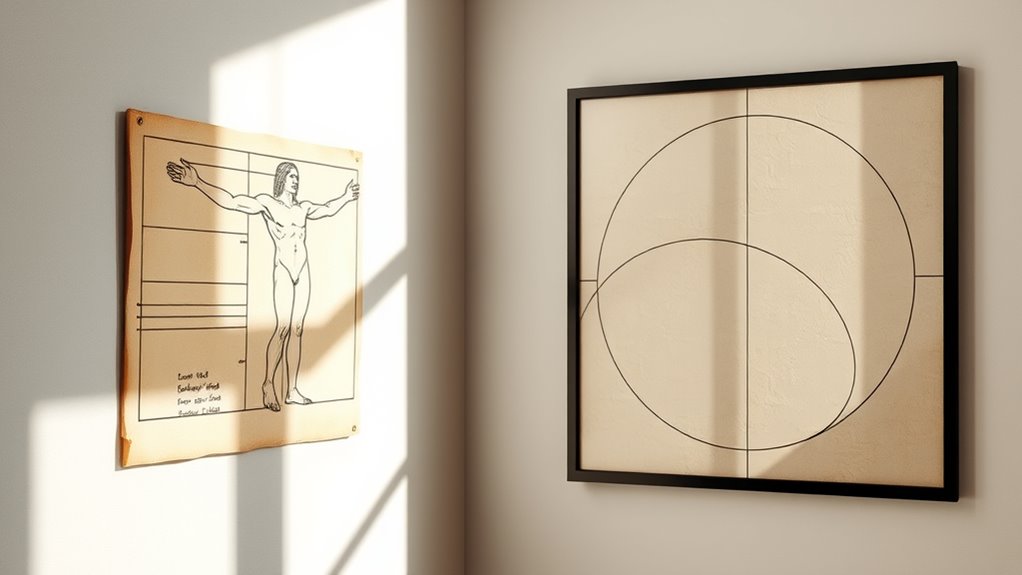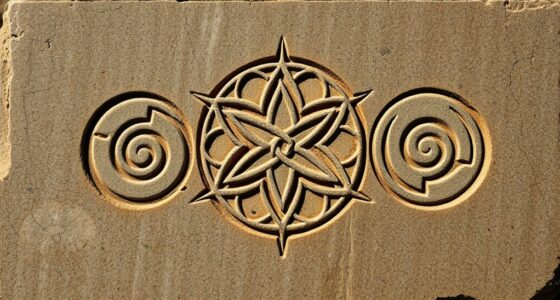The Golden Ratio has shaped art from Leonardo da Vinci’s masterpieces to modern design, serving as a universal guideline for balance and beauty. It helps you create compositions that feel natural, harmonious, and engaging. Artists and architects use this proportion to guide viewer’s eyes and evoke emotions. If you explore its application further, you’ll discover how this timeless principle continues to influence art and design today.
Key Takeaways
- The Golden Ratio has been used by masters like Leonardo da Vinci to create proportionally balanced artworks.
- It guides composition, enhancing aesthetic appeal and natural harmony in both classical and modern art.
- Artists and architects employ the ratio to structure elements, achieving visual flow and emotional impact.
- The Golden Ratio remains a universal design principle, linking historical masterpieces to contemporary visual practices.
- Its mathematical basis ensures timeless beauty, making it a fundamental tool from da Vinci’s era to today’s design innovations.

Have you ever wondered why certain artworks feel perfectly balanced and harmonious? The secret often lies in understanding the importance of mathematical proportions, especially the golden ratio, which has been used by artists for centuries to achieve aesthetic harmony. This ratio, approximately 1.618, is a unique mathematical proportion that naturally appeals to the human eye. When artists incorporate the golden ratio into their compositions, they create a sense of order and beauty that feels both effortless and compelling. It’s no coincidence that many masterpieces from Leonardo da Vinci to contemporary designers seem visually pleasing; they leverage this ancient principle to guide viewers’ attention and evoke emotional responses.
The golden ratio is more than just a numerical curiosity—it’s a tool for achieving aesthetic harmony. When you divide a line so that the longer part relates to the shorter part in the same way the whole relates to the longer segment, you’re working with the golden ratio. Artists and architects have used this proportion to structure their works, aligning elements in ways that feel natural and balanced. For example, in Leonardo da Vinci’s “Vitruvian Man,” the proportions of the human body are carefully aligned with these ratios, creating a sense of perfection rooted in mathematical precision. This deliberate use of proportions guides the viewer’s eye across the artwork in a seamless flow, making the composition more engaging and satisfying.
The golden ratio creates natural harmony by aligning proportions in art and design for balanced, engaging compositions.
In practical terms, applying the golden ratio helps you design compositions that are compelling yet not overwhelming. Whether you’re arranging elements within a painting, photograph, or even a modern graphic design, incorporating these proportions ensures that each component complements the others. It’s a subtle but powerful way to achieve visual tension and relaxation simultaneously. Many famous artworks and architectural marvels, from the Parthenon to the works of modern designers, rely on this principle to uphold their timeless appeal. When you understand and utilize the golden ratio, you tap into a universal aesthetic language that resonates deeply with viewers.
Furthermore, understanding the mathematical basis of the golden ratio allows artists and designers to create works that are not only beautiful but also inherently balanced and harmonious. When you incorporate these principles into your own work, you’re aligning with a tradition that emphasizes balance and natural beauty—creating art that feels both precise and emotionally compelling. It’s a tribute to how timeless and universal the pursuit of aesthetic harmony truly is.
Frequently Asked Questions
How Is the Golden Ratio Calculated Mathematically?
To find the golden ratio mathematically, you perform a ratio derivation where a line is divided into two parts, a longer one (a) and a shorter one (b). The ratio is calculated as a/b, which equals (a + b)/a. When you solve this proportion, it results in a quadratic equation, and the positive solution—approximately 1.618—is the golden ratio. This process helps you understand its unique mathematical beauty.
Are There Specific Tools to Measure the Golden Ratio in Artworks?
You can use digital tools like specialized software or apps to measure the golden ratio accurately in artworks. These measurement techniques allow you to overlay grids or spirals, making it easier to spot proportions that follow the golden ratio. While traditional tools like rulers and compasses work, digital tools provide precision and convenience, especially for complex compositions, turning a sometimes tricky task into a straightforward process.
Did All Renaissance Artists Use the Golden Ratio Intentionally?
Not all Renaissance artists used the golden ratio intentionally, but many relied on their artistic intuition and aesthetic principles. Historical evidence shows some artists, like Da Vinci, consciously incorporated it, yet others may have applied it subconsciously. You can see this in their compositions, where balance and harmony often align with the golden ratio, suggesting it was a guiding or intuitive tool for achieving visual appeal, even if not always deliberately calculated.
How Has the Golden Ratio Influenced Modern Architecture?
Imagine the golden thread weaving through modern architecture, shaping structures with timeless grace. You see, the golden ratio’s historical influence sparks aesthetic appeal, guiding architects to craft buildings that feel naturally balanced and harmonious. From sleek skyscrapers to elegant public spaces, this mathematical secret continues to inspire, ensuring your surroundings resonate with beauty rooted in a centuries-old quest for perfect proportion.
Are There Any Criticisms of the Golden Ratio’s Significance?
You might question the golden ratio’s significance because of subjectivity debates and concerns about its scientific validity. Critics argue that its aesthetic appeal is often overstated and influenced by cultural biases. Some believe it’s a mathematical coincidence rather than a universal design principle. While it’s historically influential, these debates highlight that its importance isn’t universally accepted, and its role in art and architecture remains a topic of ongoing discussion.
Conclusion
As you explore the golden ratio in art, you realize how deeply it influences aesthetics and composition. Did you know that over 60% of famous artworks, from Leonardo da Vinci to modern designers, subtly incorporate this ratio? By understanding its presence, you can better appreciate the harmony and balance in art and design. Keep an eye out for this timeless principle—it’s hidden in many masterpieces, shaping our visual world in ways you might not even notice.









